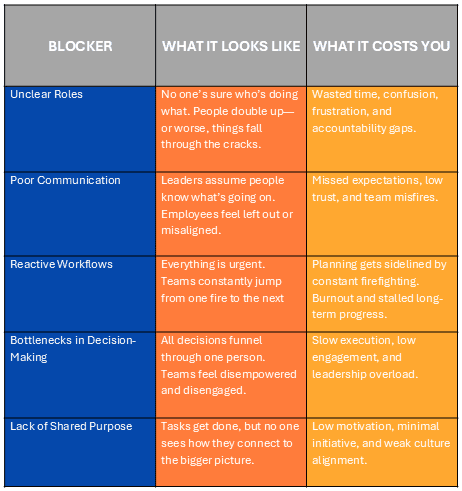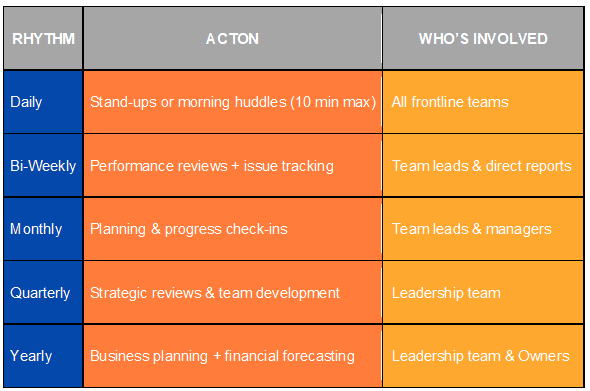It’s Not Speed That Burns People Out — It’s Friction

Speed often gets a bad name in the race to grow a business. Leaders worry that moving too fast will burn out their teams or cause mistakes. But speed itself isn’t the problem; friction is. The real challenge isn’t how fast your team moves; it’s how much resistance they face while doing it.
At Blueneck, we’ve worked with hundreds of business owners and leaders across Canada. They’re passionate about their trade, people, and the future, but many hit a wall when trying to scale. The energy that once drove the business forward starts to fade. People get tired. Teams lose focus. Progress slows.
This article explores how to maintain momentum without losing your people. We’ll unpack how to reduce friction, align effort, and build a climate of engagement so that momentum becomes a source of energy, not exhaustion.
The Speed Myth: Why Faster Doesn’t Have to Mean Burnout
Speed often gets a bad reputation in leadership circles — and for good reason. Many associate it with rushed decisions, overworked teams, and careless mistakes. But speed itself isn’t the problem. It’s unstructured speed that leads to burnout and breakdowns.
A 2023 McKinsey study found that companies operating at “strategic speed” – that is, making decisions and executing quickly with clarity, alignment and systems in place – were twice as likely to outperform their peers on both financial and operational outcomes. These companies aren’t just moving fast for the sake of it; they’re moving with purpose, coordination, and momentum.
For small business teams, this is a game-changer. You don’t need to work longer hours or push people harder to grow. You need to remove the drag. When roles are unclear, decisions are bottlenecked, and communication breaks down, your team isn’t slow, they’re stuck. The real challenge isn’t how fast your team moves. It’s how much resistance they face while doing it.
Speed + Clarity – Friction = Strategic Momentum
This is the formula we use with Blueneck clients to reframe speed not as a threat but as a strategic tool. When you combine clarity of purpose with aligned systems and reduce unnecessary blockers, your team doesn’t just move faster, they move better.
In the next section, we’ll look at what causes friction in growing businesses and how you can start fixing it.
Common Causes of Friction in Growing Businesses

Businesses often face one or more of these common speed traps. These blockers aren’t just operational snags, they’re signs your team is working harder, not smarter. When things start to feel chaotic, unfocused, or stuck in place, chances are you’re dealing with friction: invisible barriers that sap your team’s energy and stall your momentum.
What makes friction dangerous is that it builds slowly and hides in plain sight. You may not even notice it until deadlines slip, engagement drops, or people start leaving.
Use this table to identify five of the most common friction points that show up in small, growing teams — and what they’re really costing you behind the scenes.
Fixing the Friction: 6 Strategies for Sustainable Speed
Fixing these blockers doesn’t require more effort. It requires better systems, leadership, and alignment. The following six strategies will help you reduce friction, energize your team, and move your business forward without burning people out. These are practical shifts you can start making today — no overhaul required.
1. Clarify the “Why”: Purpose Creates Energy
When people understand why they’re doing something, they bring more energy to how they do it. According to Gallup, employees who strongly connect with their organization’s mission are 4 times more likely to be engaged at work.
As a leader, your job is to link the day-to-day with the long-term vision:
- Share your goals clearly and often.
- Involve the team in planning so they feel ownership.
- Explain how each role contributes to the big picture.
This doesn’t need to be a motivational speech. Just consistent, clear communication.
2. Build Aligned Teams: Right Seats, Right People
Having great people is one thing. Putting them in the right roles is another. When skills and responsibilities don’t match, teams stall.
What you can do:
- Use simple org charts to define who does what.
- Cross-train staff to reduce bottlenecks and increase flexibility.
- Invest in development coaching, peer mentoring, and even job shadowing.
Aligned teams don’t just get more done, they solve more problems before they reach you.
3. Make Decision-Making Easier (and Faster)
If every decision must go through you, your business is stuck and not scalable.
Try this:
- Set decision thresholds: What must come to leadership vs. what teams can own?
- Create templates: Standardize common workflows (e.g., quoting jobs, approving time off).
- Coach confidence: Train your managers to make decisions within guardrails.
Faster doesn’t mean riskier. It means trusting your team with the right tools and frameworks.
4. Prioritize People, Not Just Performance
The fastest-growing companies understand that culture drives performance. When people feel supported and valued, they contribute more.
Build it by:
- Daily or weekly team check-ins (15 min max).
- Monthly “state of the business” updates.
- Quarterly performance + wellness check-ins (not just productivity-based).
- Celebrating small wins publicly and consistently.
According to Deloitte, organizations with strong cultures have 30% higher levels of innovation and 40% higher retention.
5. Operational Rhythm - Sustainable Speed
You don’t need more hustle. You need more operational rhythm, predictable, repeatable cycles that create momentum.
Here’s a sample cadence we use with our Blueneck clients:

6. Track Energy, Not Just Output
Too many businesses only measure what’s easy: sales, hours worked, and tasks completed. But if you want sustainable speed, you need to measure team energy.
Try these pulse questions (monthly or quarterly):
- “On a scale of 1–10, how energized do you feel at work?”
- “Do you feel clear on your priorities?”
- “What’s blocking you from moving faster?”
Use these insights to fine-tune workflows, reduce stress, and spot burnout before it hits.

A Real-World Example: From Chaos to Cadence
One of our manufacturing clients was struggling with high turnover, missed deadlines, and rising frustration on the floor. They had the talent — but no consistent systems, clear roles, or reliable communication rhythms. Everything was reactive. People were constantly firefighting, and leaders felt like they were stuck in the weeds.
After working with Blueneck, they started to make small changes to help resolve these identified issues: clarifying roles and expectations, setting up a weekly operational rhythms, and empowering mid-level leads to make day-to-day decisions without waiting for executive sign-off. They also introduced a simple check-in cadence to keep communication flowing and identify blockers early.
Within a few months, on-time delivery rates increased, employee satisfaction rose to an all-time high, and the leadership team finally had time to focus on growth instead of daily chaos.
Strategic speed doesn’t mean running harder. It means removing what slows you down — so your people can move with clarity, confidence, and energy.

Final Thoughts: Speed Is a Leadership Skill
Sustainable speed starts at the top.
For businesses across Canada, the challenge isn’t about slowing down. It’s about moving in the right direction, together, without burning out.
At Blueneck, we help owners and leadership teams build smarter systems that unlock their full potential without burning people out.
Ready to Build Strategic Momentum?
If you’re a Canadian business owner tired of spinning your wheels, it might be time for a tune-up, not a teardown. Let’s reduce friction, rebuild focus, and create a rhythm that moves your business forward – without the burnout.
Let’s build momentum, together!

